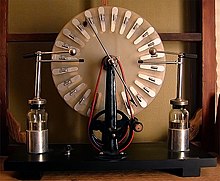Wimshurst-generator
Wimshurst-generatoren eller Wimshurst-influensmaskinen er en elektrostatisk generator, som genererer højspænding og som blev udviklet mellem 1880 og 1883 af den britiske opfinder James Wimshurst (1832–1903).
Wimshurst-generatoren har en distinkt udseende med to stor modsat roterende skiver monteret i et lodret plan, med to krydsende ledere med metalbørster - og et gnistgab, der udgøres af to metalkugler.
Kilder/referencer
- "History of Electrostatic Generators". Hans-Peter Mathematick Technick Algorithmick Linguistick Omnium Gatherum.
- de Queiroz, Antonio Carlos M., "The Wimshurst Electrostatic Machine"
- Weisstein, Eric W., "Wimshurst Machine".
- Bossert, François, "Wimshurst machine Arkiveret 5. august 2004 hos Wayback Machine". Lycée Louis Couffignal, Strasbourg. (English Arkiveret 5. august 2004 hos Wayback Machine version)
- Charrier Jacques "La machine de Wimshurst". Faculté des Sciences de Nantes.
Se også
- Kelvingenerator
- Pelletron
- Van de Graaff-generator
- Tesla-spole
Eksterne henvisninger
| Wikimedia Commons har medier relateret til: |
Medier brugt på denne side
Suppose that the conditions are as in the figure that is the segment A1 is positive and the segment B1 negative. Now, as A1 moves to the left and B1 to the right, their potentials will rise on account of the work done in separating them against attraction. When A1 comes opposite the segment B2 of the B plate, which is now in contact with the brush Y, it will be at a high positive potential, and will therefore cause a displacement of electricity along the the conductor between Y and Y1 bringing a large negative charge on B2 and sending a positive charge to the segment touching. As A1 moves on, it passes near the brush Z and is partially discharged into the external circuit. It then passes on until, on touching the brush X it is put in connection with X, and has a new charge, this time negative, driven into it by induction from B2. Positive electricity, then, being carried by the conducting patches from right to left on the upper half of the A plate, and negative from left to right on its lower half.
A Wimshurst machine, an electrostatic generator which generates high voltage static electricity with two counterrotating disks turned by a crank.
Forfatter/Opretter: Pappnaas666, Licens: CC BY-SA 3.0
Wimshurst Machine at work
Forfatter/Opretter: Grandfatherclok, Licens: CC BY-SA 3.0
As each uncharged plate (black moving square) contacts a commutator (arrow-tipped line), it takes on charge (red + or green -) under the influence of the plate on the opposite disk. As each pair of same charged plates contacts a commutator (arrow tipped line), their charge pumps the Leyden jar (triangles) limited (yellow spark) by the breakdown voltage.








